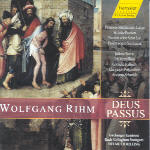Deus Passus is one quarter of the Passion Project 2000, which celebrated not only the turning of the millennium but also commemorated the 250th anniversary of Bach’s death. German conductor Helmuth Rilling honored this occasion by commissioning Passions from four disparate composers: Wolfgang Rihm, Tan Dun, Sofia Gubaidulina, and Osvaldo Golijov. Deus Passus is a setting of the Passion according to St. Luke, and it is a marvel of a piece for many reasons. For a full hour and a half, with music that is mostly slow and largely atonal (in the sense that Berg’s music is atonal), the twisting, aching, unpredictable harmonies are totally captivating. Rihm chooses a straightforward setting, a simple, dramatic telling of the story, and it is in his capacity for restraint that the true brilliance of the piece lies. He uses the chorus sparingly, mostly for dramatic purposes, having it portray the angry rabble bent on crucifying Jesus (as it often does in Bach’s passions). He employs percussion even less frequently, making it especially brutal when it is used, particularly as it depicts hammers driving the nails into Christ’s hands.
Rihm capitalizes on the history of the Passion, drawing on Bach as an influence, but where other composers who aim for the “modern ancient” kind of sound fail (people like John Tavener) Rihm succeeds because of his thoroughly musical (as opposed to blandly philosophical) mind. He has created a work that is truly timeless, being both progressive and ageless. Helmuth Rilling has a deep and serious understanding of this piece–his pacing is appropriately slow and menacing but never simply plods along, and he finds both the individual lines and the harmonies they outline.
The performances are all appropriately hushed, saving the sturm and drang for the proper moments. Soprano Juliane Banse has an exquisitely piercing quality, ideal for the agitated “Qui cogitaverunt malitas”, one of the work’s rare fast sections. Her voice balances nicely against Iris Vermillion’s mezzo and Cornelia Kallisch’s dark, smoky alto–and all of the singers are capable of blending with one another. This is used to dazzling effect in the final movement, a setting of Paul Celan’s holocaust poem “Tenebrae”. Rihm uses all of his forces for this twist-the-knife ending, a bringing of the passion to modern times by simply relating it to a more modern tragedy. The recording, a live performance (though you would never be able to tell save for the applause at the end) captures the emotional intimacy that this piece demands–everything is recorded closely and well, and the sound of the orchestra is both “ancient” and lush.
































